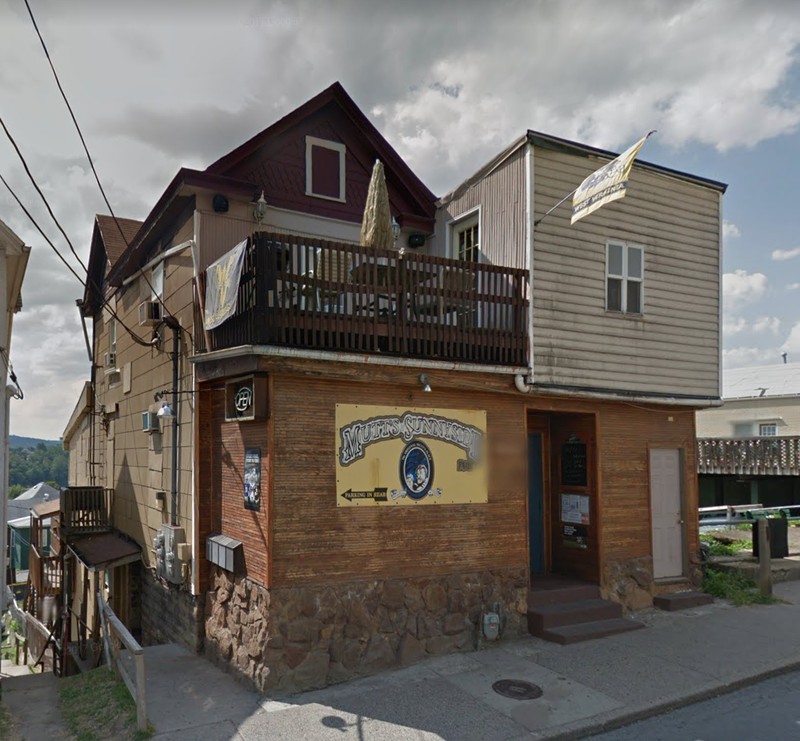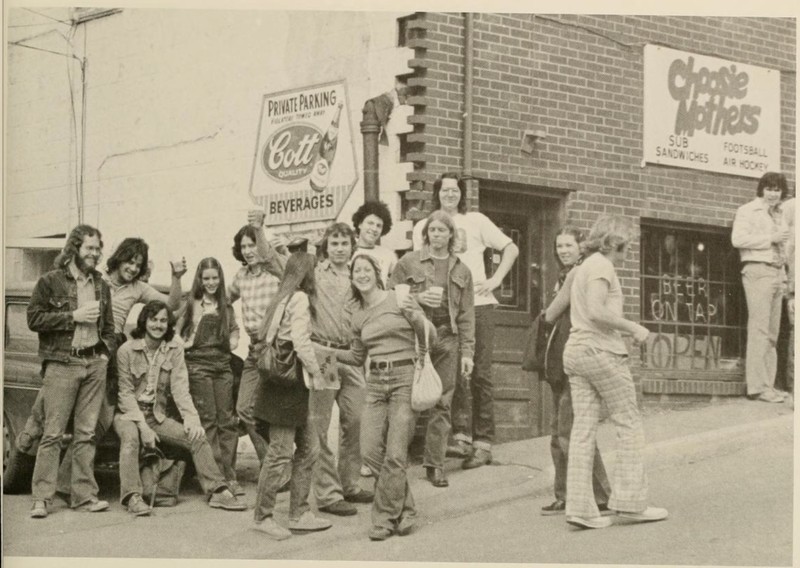Mutt's Sunnyside Place (1979-2013 location)
Introduction
Text-to-speech Audio
Images
The second location of Mutt's Sunnyside Place was demolished in 2013 to make way for University Place, a multiuse apartment complex within walking distance of WVU's Downtown campus. Google Street View.

Sunnyside’s restaurants and pubs began catering to student interests, changing the business makeup of the neighborhood. Here, students gather outside a pub in Sunnyside called Choosie Mothers. WVU Monticola, 1978.

Backstory and Context
Text-to-speech Audio
In 1979, 2129 University Avenue opened its doors as Mutt’s Sunnyside Place. This beloved bar signified student influence over the neighborhood’s businesses and social activities. Morgantown historically has been home to drinking establishments; among the first businesses downtown were taverns and breweries, which served immigrants heading westward. As Morgantown developed into a college town, an enthusiastic market of students kept taverns in business throughout the city. Drinking had long been associated with student culture, and Sunnyside’s identity as a center of student life attracted more bars, pubs, and taverns to the neighborhood in the mid-twentieth century.1
Mutt’s was originally situated on Beechurst Avenue. Opened in 1935, the business was owned by Mottie “Mutt” Pavone, the son of Italian immigrants, and his wife Rose Poropatt Pavone, a Yugoslavian immigrant. After Mottie’s death in 1955 at age 51, Rose continued to operate the business independently. Their son, Mottie, who also went by the nickname “Mutt,” worked in real estate, owning Hampton North Mobile Home Park and Pavone Rentals. He acquired 2129 University Avenue in 1972 and rented the property to students. In 1979, a fire destroyed Mutt’s original location on Beechurst Avenue. The Pavones found a new home for Mutt’s in the house at 2129 University Avenue. Rose turned over operations to her son, who rented the apartment above the pub.2
The house at 2129 University Avenue, originally called 93 Beverly Avenue before the street name was changed, dated back to the early twentieth century. Prior to becoming a pub in 1979, the house was rented by a number of families, most of whom were white, working class, and relied on Morgantown’s industries for employment. Many of these families transitioned from farm work to industry at the turn of the twentieth century and moved around frequently, likely responding to broader changes in their respective industries. The Ireland and Wharton families, for example, rented the house in the 1910s and had family members working in the coke, tin, and glass industries. The first longtime residents at the house, the Hamiltons, lived in the house between the 1920s and 1940s. The Hamiltons left their farm on the edge of Morgantown to live in Sunnyside, where the father, Isaac, worked as a carpenter, and the sons worked as carpenters or laborers in a local rubber factory. The Hamiltons also took in boarders, which may have been an attractive form of supplemental income as Isaac and Annie Hamilton’s sons found work in Ohio and Illinois. After Isaac Hamilton’s death in 1945, the house received its next long-time residents in Frank and Denise Pierre, glassworkers from Belgium who, according to Census records, spoke French in their home. The Pierres also rented rooms to boarders, including two women who worked in clothing manufacturing and at Seneca Glass, a WVU student on the GI Bill after World War II, a WVU professor, and a clerk at the MountainLair. The Pierres sold the house in the 1960s, when it was purchased by a landlord who rented almost exclusively to WVU students.3
Beginning in the 1970s, Sunnyside became a student-dominated neighborhood as West Virginia University grew and local industry declined. Sunnyside offered cheap rental houses and social spaces like Mutt’s. One student writer recalled in 1983, “A new student may not know where his classes are, but he can find all the bars in Sunnyside.”4 Mutt’s was known for its “all-you-can-eat” spaghetti lunches on Saturdays that served students facing shoestring budgets and the fallout of indulgent drinking.5 For three decades, Mutt’s was an important student institution. In the 1970s-80s, students in Sunnyside developed traditions such as the Grant Avenue block parties and couch burnings, often held after WVU football games, when student spectators would pour out of Old Mountaineer Field into the streets of Sunnyside. However, the fun, when coupled with alcohol abuse, was also met with instances of rowdiness, violence, vandalism, and sometimes the injury or death of students due to drunk driving or alcohol poisoning. These parties and the dilapidated conditions of Sunnyside’s housing became known as the “Sunnyside problem” that put the neighborhood under scrutiny.6
As Sunnyside moved into the twenty-first century, WVU and Morgantown developers looked toward the neighborhood to create a more inviting, attractive, and safer place for students to live. On October 23, 2012, West Virginia University’s Board of Governors approved acquisition of a five-acre plot of Sunnyside to build University Place. This meant the end of Mutt’s Sunnyside and 38 of its neighboring properties. WVU entered into a public-private partnership with Paradigm Development Group, which said in a 2012 interview that University Place “will expand student housing and retail options in Sunnyside – and will revitalize an unattractive dilapidated area into a beautiful, safe and affordable place for students, faculty, staff and citizens to live, work and shop.”7 Mutt’s location on University Avenue was closed at the end of January and the building demolished on April 4, 2013. The business moved to Beechurst Avenue shortly thereafter. Yet the loss of Mutt’s signaled an end of an era for a number of students and alumni who frequented the pub and Sunnyside’s social scene.8 As the neighborhood undergoes change, Mutt’s represents the shift from an industrial, working class Sunnyside to a center of student life.
Sources
1. James Morton Callahan, History of the Making of Morgantown, West Virginia: A Type Study in Trans-Appalachian Local History (Morgantown: Morgantown Printing and Binding Company, 1926), 85, 113, 129; John J. Sloan III and Bonnie S. Fisher, The Dark Side of the Ivory Tower: Campus Crime as a Social Problem (Cambridge: Cambridge University Press, 2011), 10-16.
2. “Rose E. Poropatt Pavone,” Find a Grave, accessed April 5, 2016. http://www.findagrave.com/cgibin/fg.cgi?page=gr&GRid=20073249; 1930 U.S. Census, Star, Monongalia County, West Virginia. p. 2A, Mottie Pavone, digital image, Ancestrylibrary.com, accessed April 5, 2016. http://search.ancestrylibrary.com/cgibin/sse.dll?db=1930usfedcen&indiv=try&h=100703016; Deed of Sale, George Batlas to Mottie Pavone, July 1972, Monongalia County, West Virginia, Deed Book 724, p. 48 Office of the Recorder of Deeds, Morgantown, WV.
3. Morgantown City Directory (Pittsburgh: R.L. Polk and Company, Publishers, 1914, 1924, 1949, 1954); Parkersburg City Directory (Pittsburgh: R.L. Polk and Company, Publishers, 1924) 828; 1900 U.S. Census, Walker, Wood County, West Virginia, enumeration district: sheet 11A, dwelling 195, family 198, lines 35-42, Peter Wharton, digital image, Ancestrylibrary.com (accessed April 3, 2016), T623, Roll 1854; West Virginia Marriages Index, 1785-1971, “Isaac Hamilton and Annie Zinn,” Ancestry.com (Accessed March 6, 2016).; 1930 U.S. Census, Morgantown, Monongalia County, West Virginia. p. 1B, dwelling 20, family 25, Isaac Hamilton, digital image, Ancestrylibrary.com (accessed March 4, 2016) T626, roll 2548; Deed of Sale, Isaac Hamilton heirs to Frank Pierre, October 18, 1945, Monongalia County, West Virginia, Deed Book 370, p. 489; Office of the Recorder of Deeds, Morgantown, West Virginia.
4. Karen Garvin, “Activity Thrives After Hours,” Monticla (1983), 16-17.
5. Nettie Fowler, “Eat it Up: Command the Genie of Extravagance as Student Hunger,” Monticola (1985), 39; Sharman Peters, “No liquor in Sunnyside, court injunction filed,” The Daily Athenaeum, August 25, 1982, 1-2.
6. William T. Doherty, Jr. and Festus P. Summers, West Virginia University: Symbol of Unity in a Sectionalized State (Morgantown: West Virginia University Press, 1982), 327-328; Ronald L. Lewis, Aspiring to Greatness: West Virginia University Since World War II (Morgantown: West Virginia University Press, 2013), 304-306, 486-489.
7. University Relations/News, “WVU engages in public-private partnership to develop a $70 million mixed use residential and retail complex in Sunnyside,” WVU Today, Oct. 26, 2012, http://wvutoday.wvu.edu/n/2012/10/26/wvu-engages-in-public-private-partnership-to-develop-a-70-million-mixed-use-residential-and-retail-complex-in-sunnyside
8. “From Mutt’s Place to University Place: Annual Report 2013-2014,” Campus Neighborhoods Revitalization Corporation (Feb. 2014): 12. Accessed April 4, 2016. http://sunnysideupwv.org/images/CNRC--2014_Annual_Report_July_10.pdf; Carlee Lammers, “Students react to news of University's $70 million plan for ‘University Place’ in Sunnyside,” The Daily Athenaeum, October 29, 2012, Accessed April 3, 2016 http://www.thedaonline.com/article_075625f2-7fa4-5894-8fcd-83bc1804ac05.html
Research compiled by Pamela Curtin. Edited by Elizabeth Satterfield and Pamela Curtin.
